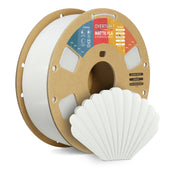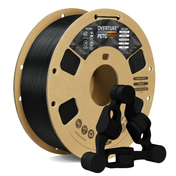Coinnect: Students Building Change with 3D Printing
By Coco He | November 2025
Read Time: 4 min
For Vince, Stunley, and Raziel, 3D printing wasn’t just a tool, it was the moment their thesis project became possible. As computer engineering students at the University of Mindanao, they set out to build a kiosk that could accept and sort both coins and bills. But many of the parts they needed simply didn’t exist on the market. With limited budgets, manufacturing them from metal wasn’t realistic.
“3D printing gave us the freedom to design exactly what we needed without worrying about high costs,” the team explained. It allowed them to move from sketches to testable parts, and then to a working prototype.

From Frustration to Breakthrough
The coin sorter was one of the toughest challenges. Because two coins were nearly the same size, their first ideas didn’t work. After countless redesigns, they finally built a servo-based mechanism that read each coin and sent it to the correct slot. “When we finally saw it working in real time, it was one of the most satisfying moments of the whole build.”
Of course, the road wasn’t easy. Prints often needed adjustments. “Printing is never perfect on the first try,” Raziel shared. “Sometimes holes come out too small, or measurements are just a little bit off.” With Overture’s reliable filament, they could focus on improving designs instead of worrying about failed prints. Each trial became a step forward rather than a setback.
Their proudest accomplishment was the bill sorter. Inspired by the lead screws in their own 3D printer, they adapted the same idea to move storage trays precisely into place. Turning that inspiration into a working system felt like solving a puzzle they once thought was beyond their reach.

Support That Made a Difference
Resources were tight, so the team began looking for help wherever they could. “Before reaching out, I always did background checks, and that’s when I found Overture’s partnership program,” Raziel shared. The support came at just the right time. With Overture’s reliable filament, their prints became stronger, cleaner, and far more precise than before. What had started as a fragile, test-run prototype became a stable, professional-looking machine that finally worked the way they imagined.
When they first presented the improved machine, the change was obvious. Their instructor, who had once smiled at its rough wooden frame, was genuinely impressed by how refined it had become. Friends and classmates were surprised to see the coins sliding effortlessly into place — a small but powerful moment that showed how much the team had grown. For them, it wasn’t just about the machine working; it was about seeing how far they’d come with the right tools and a bit of support.

Beyond the Thesis
Coinnect has since grown into something bigger than a class requirement. The team credits Overture’s support as the push that turned their prototype into something they could be proud of — and now, they want to help others experience the same.Vince, Stunley, and Raziel have started helping other students gain access to 3D printing, sharing what they’ve learned and offering support to those beginning their own projects.
Their journey reflects Overture’s vision of “3D printing for everyone.” With accessible, dependable tools, even students with limited resources can create solutions that matter.
Coinnect may have started in a classroom, but it carries a larger message: with persistence, creativity, and the right support, innovation is within reach for anyone willing to try.

Explore the Filaments That Power Purpose




